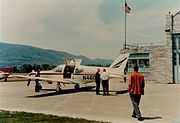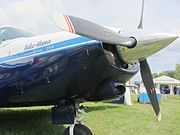Piper PA-24 Comanche
The Piper PA-24 Comanche is a four-seat, low-wing, all-metal, light aircraft of monocoque construction with retractable landing gear. Piper Aircraft designed and developed the Comanche; it first flew on May 24, 1956. Together with the Twin Comanche, it made up the core of the Piper Aircraft lineup until 1972, when the production lines for both aircraft were wiped out in a flood.
Design and development

The Comanche is a four-seat, single-engined, low-wing monoplane. It is an all-metal aircraft with a retractable landing gear.[2] Two prototypes were built in 1956 with the first being completed by June 20, 1956.[2] The first production aircraft, powered by a 180 hp (134 kW) Lycoming O-360-A1A engine, first flew on October 21, 1957. In 1958 it was joined by a higher powered PA-24-250 with a 250 hp (186 kW) Lycoming O-540-A1A5 engine; this model was originally to be known as the PA-26 but Piper decided to keep the PA-24 designation.[2][3]
In 1964 the 400 hp (298 kW) PA-24-400 was introduced.[1] The following year the PA-24-250 was superseded by the PA-24-260, featuring the Lycoming IO-540D or E engine of 260 hp (194 kW). The 260 was also available as the Turbo Comanche C with a Rajay turbocharger and was introduced in 1970.[4]
Production of the Comanche ended in 1972 when torrential rains from Hurricane Agnes caused the great Susquehanna River flood of 1972, flooding the manufacturing plant and destroying airframes, parts, and much of the tooling necessary for production. Rather than rebuild the tooling, Piper chose to abandon production of the Comanche and Twin Comanche and continue with two newer designs already in production at Piper's other plant in Vero Beach, Florida: the twin engine PA-34 Seneca and the PA-28R-200 Arrow.[5]
Variants
Comanche 180

The original version of the Comanche was the PA-24, which featured a carbureted 180 hp (134 kW) Lycoming O-360-A1A engine, swept tail, laminar flow airfoil, and all-flying stabilator.
The standard fuel capacity of the PA-24-180 was 60 US gallons (230 L). The flaps were manually actuated, controlled by the same Johnson bar actuator as the Piper Cherokee. The aircraft specifications were for cruise speeds of 116 to 139 knots (215 to 257 km/h) and fuel burns between 7.5 and 10.5 gph at 55-percent and 75-percent power settings. Full-fuel payload with standard fuel was 715 pounds, with a gross weight of 2,550 lb (1,160 kg) and range with 45-minute reserve of 700 nautical miles.[citation needed]
When new, standard, average-equipped Comanche 180s sold between $17,850 (1958) and $21,580 (1964). A total of 1,143 were built.[citation needed]
Comanche 250
In 1958 Piper introduced a 250-horsepower (186 kW) version using a Lycoming O-540 engine, giving the PA-24-250 Comanche a top cruise speed of 160 kts (185 mph; 298 km/h). Most 250s had carbureted Lycoming O-540-AIA5 engines, but a small number were fitted out with fuel-injected versions of the same engine. Early Comanche 250s had manually operated flaps and carried 60 US gallons (230 L) of fuel. Auxiliary fuel tanks (90 US gallons (340 L) total) became available in 1961. Electrically actuated flaps were made standard with the 1962 model year. The aircraft's gross weight was increased from 2,800 pounds to 2,900 pounds in 1961, making the useful load 1,270 pounds.[citation needed]
The Comanche 250 advertised cruise speeds of 140-157 knots and fuel burns of 10-14 gph (55% and 75% power).[citation needed]
Prices of new Comanche 250s ranged from $21,250 (1958) to $26,900, which was only $3,000 to $5,000 more expensive than the Comanche 180. Some 2,537 were sold.[citation needed]
Comanche 260


In 1965 the first of four 260-horsepower (194 kW) versions of the Comanche was introduced. They were:
- PA-24-260 (1965)
- PA-24-260B (1966 to 1968)
- PA-24-260C (1969 to 1972)
- PA-24-260TC
A total of 1,029 airplanes were sold from the Comanche 260 line, including the 260TC. Thirty-eight Comanche 260s were delivered with carbureted engines; the rest used the fuel-injected Lycoming IO-540 engine.[citation needed]
The 260 had an empty weight of approximately 1,700 pounds and a max gross weight of 2,900 pounds. It had four seats, and a 90-US-gallon (340 L)-capacity auxiliary fuel system was available as an option. Cruise speed was advertised as 142-161 knots with fuel burn of 10 to 14 US gallons (38 to 53 L) per hour. New, they sold for approximately $30,740.[citation needed]
The 260B had an overall length six inches (152 mm) more than the previous models. This was due to a longer prop spinner, not a longer fuselage. The 260B had a third side window and a provision for six seats. The fifth and sixth seats take up the entire baggage area and will seat smaller adults and is placarded to a total weight of 250 pounds. Typical empty weight was 1728 pounds and gross weight was 3,100 pounds. Fuel burn was 11 to 14 US gallons (42 to 53 L) per hour and advertised speed was 140-160 knots. New, they sold for $32,820 to $33,820.[citation needed]
The 260C introduced a new "Tiger Shark" cowling, max gross weight of 3200 pounds, cowl flaps, and an aileron-rudder interconnect. Cruise speed was advertised as 150-161 knots with fuel flow of 12.5 to 14.1 US gallons (47 to 53 L) per hour. To prevent possible aft center of gravity problems due to the increased gross weight and its fifth and sixth seats, the propeller shaft was extended. This moved the center of gravity slightly forward. With a useful load of 1427 pounds it has the largest payload of all of the Comanches except the 400. Often mistaken on the ramp for the 400 model, the slightly longer cowling includes a distinctively longer nose gear door, as compared to the B models and older versions. The 400 model does not have 3 side windows as with the B and C models. New, they sold for $36,550 to $45,990.[citation needed]
Starting in 1970 a turbocharged variant of the PA-24-260 was available with a Lycoming IO-540-RIA5 engine.
PA-24-300
In 1967 one aircraft was modified with a 300 hp (224 kW) Lycoming engine for trials. It did not enter production.[2]
PA-24-380
Two prototype aircraft were built in 1961. They were standard Comanche airframes but had 380 hp (283 kW) Lycoming IO-720-A1A engines with a three-blade propeller. The design was modified with an even larger 400 hp (298 kW) engine and produced as the PA-24-400.[6]
Comanche 400
The PA-24-400 Comanche 400,[7] while identical in planform to other single-engined Comanches, is structurally strengthened, primarily in the tail. The aircraft has an extra nose rib in the stabilator and in the vertical fin. The stabilator, vertical fin, and rudder of the 400 share virtually no common parts with the 180, 250, or 260 hp (190 kW) Comanches. In addition, the 400's rudder is aerodynamically balanced in a manner similar to that of the Piper PA-30 Twin Comanche and does not have the lead external balance weights of the lower-powered single-engine Comanches.[citation needed]
The Comanche 400 is powered by the 400-horsepower 8-cylinder Lycoming IO-720 engine, an engine developed specifically for the Comanche.[8]
The aircraft was produced from 1964 to 1966,[1] with only 148 PA-24-400s having been built. The aircraft's high fuel burn means that it is expensive to operate. There have been cooling problems with the rear cylinders of the horizontally opposed eight cylinder engine. Even with the huge engine, the PA-24-400 manages a top speed of only 194 knots (360 km/h) and cruising speed of 185 knots (343 km/h), considerably slower than more modern light aircraft, such as the Cessna 400, operating with much less horsepower.[9]
The Comanche 400 has a three-blade propeller and carries 100 US gallons (380 L) of fuel, or 130 US gallons (490 L) with optional extended tanks. Fuel burn was advertised as 16 to 23 US gallons (61 to 87 L) per hour, at 55%-75% power. The 400 had a typical empty weight of 2,110 pounds and a max gross weight of 3,600 pounds. New base price for 1964 was $28,750.[citation needed]
Twin Comanche
PA-33

In 1967 a single Comanche was modified by Swearingen with a pressurized cabin. The prototype, powered by a 260-hp Lycoming O-540 engine and equipped with Twin Comanche landing gear, was designated the PA-33.[10] First flown on March 11, 1967, the prototype later crashed on takeoff in May 1967 and the project was cancelled.[10]
World records
Max Conrad
In June 1959 Max Conrad flew a Comanche 250 on a record-breaking distance flight in Fédération Aéronautique Internationale C1-D Class, for aircraft between 3,858 lb (1,750 kg) to less than 6,614 lb (3,000 kg). Having removed the interior seats and replaced them with fuel tanks, Conrad flew non-stop from Casablanca, Morocco to Los Angeles, a distance of 7,668 mi (12,340 km). When the aircraft took off from Casablanca, it was heavily overloaded and just cleared the airport fence.[11] The Comanche 250 which Max Conrad flew for this flight is now located in the museum at the Liberal, Kansas airport.
On November 24, 1959 Conrad flew a Comanche 180 on a record flight in FAI C1-C Class for aircraft taking off at weights between 2,204 lb (1,000 kg) to less than 3,858 lb (1,750 kg)) that still stands: Casablanca to El Paso, Texas 6,966 mi (11,211 km) non-stop.[11]
Toku-Hana

In July 1964 Henry Ohye, flying a 1961 PA-24-250, made the first successful trans-Pacific flight from the United States to Japan in a single engine aircraft. He departed from Los Angeles to Tokyo with stops in Honolulu, Hawaii, Midway, Wake, Guam, and Okinawa.[12][13]
Myth Too
A Comanche named Myth Too and registered G-ATOY was owned by the English aviatrix Sheila Scott. The aircraft holds ninety world class light aviation records. It is on public display at the National Museum of Flight, Scotland.[14]
Accidents
Country music singers Patsy Cline, "Cowboy" Lloyd Copas and Hawkshaw Hawkins were on board a Comanche owned and piloted by Cline's manager, Randy Hughes, when it crashed in deteriorating weather near Camden, Tennessee on March 5, 1963, killing all on board.[15]
Specifications (PA-24-260)

Data from Janes[4]
General characteristics
- Crew: One
- Capacity: Three passengers
- Length: 25 ft 0 in (7.62 m)
- Wingspan: 36 ft 0 in (10.97 m)
- Height: 7 ft 6 in (2.29 m)
- Empty weight: 1773 lb (804 kg)
- Useful load: 1427 lb (647 kg)
- Max. takeoff weight: 3200 lb (1451 kg)
- Powerplant: 1 × Lycoming IO-540, 260 hp (194 kW)
Performance
- Cruise speed: 161 knots (298 km/h) 185 mph
- Range: 1063 nm (1970 km)1225 sm
- Service ceiling: 19500 ft (5945 m)
- Rate of climb: 1320 fpm (6.7 m/s)
References
- ↑ 1.0 1.1 1.2 Plane and Pilot: 1978 Aircraft Directory, page 64. Werner & Werner Corp, Santa Monica CA, 1977. ISBN 0-918312-00-0
- ↑ 2.0 2.1 2.2 2.3 Peperall/Smith 1987, pp.105-110
- ↑ The PA-26 was later used as a designation for the Comanche 400 although it also retained the PA-24 designation for marketing.
- ↑ 4.0 4.1 Taylor, John WR, editor: Jane's Light Aircraft, page 165. Jane's Publishing Company, 1982. ISBN 0-7106-0195-6
- ↑ "The Piper Aircraft Corporation, out of its Lock Haven, Pennsylv". Retrieved 2013-07-26.
- ↑ Peperell/Smith 1987, pp. 111-112
- ↑ Federal Aviation Administration (August 2006). "PA-24-400 Type Certificate". Retrieved 2007-11-30.
- ↑ Lycoming Engines (undated). "Lycoming IO-720". Retrieved 2008-12-19.
- ↑ Demand Media (2008). "The Piper PA-24 Comanche". Retrieved 2008-12-20.
- ↑ 10.0 10.1 Peperell/Smith 1987, p. 225
- ↑ 11.0 11.1 Meunier, Claude (December 2007). "Max Conrad". Retrieved 2009-08-15.
- ↑ "Trans-Pacific Flier Returns on Airliner". Los Angeles Times. 5 October 1964.
- ↑ AWA Airways: 6. Summer 2012.
- ↑ "National Museum of Flight Scotland - Our aircraft". National Museums of Scotland. Retrieved 2009-07-05.
- ↑ Anderson, Sherry (January 2001). "Patsy Cline". Retrieved 2008-10-09.
- Peperell, Roger W; Smith, Colin M (1987). Piper Aircraft and their forerunners. Tonbridge, Kent, England: Air-Britain. ISBN 0 85130 149 5.
External links
![]() Media related to Piper PA-24 Comanche at Wikimedia Commons
Media related to Piper PA-24 Comanche at Wikimedia Commons
| ||||||||
| ||||||||||||||